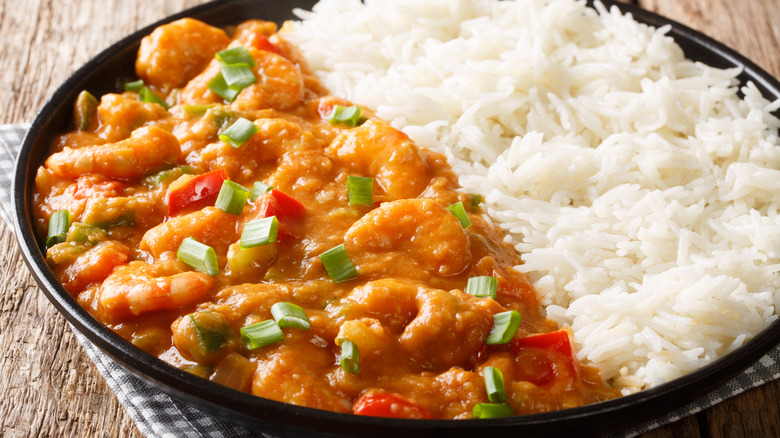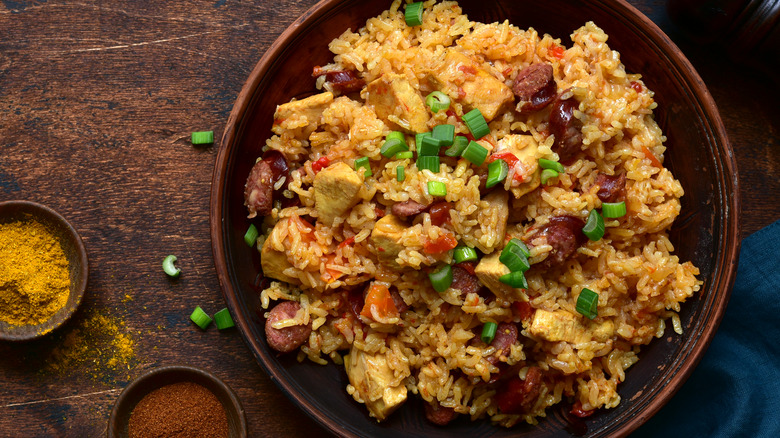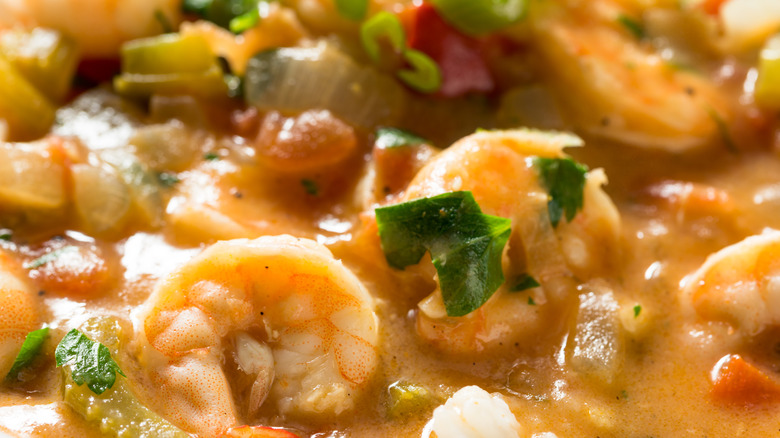The Difference Between Jambalaya And Étouffée
Jambalaya and étouffée are often confused with each other. Surely, it makes sense since both originate from Creole cuisines, usually include a variety of seafood, and are balanced by grains. Both jambalaya and étouffée are among the more hearty, brothy stews one can enjoy, thickened and spiced with a medley of mild peppers and alliums.
Jambalaya and étouffée both come from Louisiana — drawing from the many cultures that settled there — in the case of jambalaya, a mix of African, French, Spanish, and Native American influence, while étouffée (a French word for slow cooking) utilizes a French roux base and aspects of Spanish sofrito (via 196 Flavors). What further complicates the distinction between these two iconic dishes is how frequently recipes vary from household to household, person to person. It's possible one's jambalaya recipe could contain identical ingredients to another's étouffée recipe, but there are some critical differences between these Creole dishes that make them unique.
Jambalaya is a rice dish
Jambalaya is distinct from both gumbo and étouffée in that rice is an integral component, cooked into the dish like Spanish paella, rather than being served as a side. Although there are differences in flavor and appearance between the two dominant types of jambalaya, Creole and Cajun, both contain cooked rice. Our traditional jambalaya recipe begins with smoking the meats to leave a golden, caramelized protein to coat the bottom of the pan. After the meat is cooked, the classic mix of celery, onion, and bell pepper is added, which is the trio of vegetables derived from French mirepoix. Once the vegetables are sauteed and broth is added, the meat is placed back in with uncooked rice.
According to Cooking Light, this is the point where Creole and Cajun iterations of jambalaya diverge: Creole adds seafood and tomatoes during this step to make a red jambalaya. Cajun jambalaya lacks tomato, and relies more on the caramelized meat as a flavor base. As the rice cooks, it absorbs much of the broth, resulting in a thick, moist rice stew.
Another distinction is that jambalaya generally doesn't contain any thickening agents like a roux or cornstarch slurry; instead, jambalaya naturally thickens up with the starch of the rice, and the absorption of liquid. Jambalaya is hearty, scoopable, and drier than its sibling étouffée, although both are made with essentially the same seasonings and vegetables.
Étouffée is served with rice
With its French name, étouffée has a clear French influence, using the same celery, onion, and bell pepper mix found in jambalaya. According to 196 Flavors, étouffée originated from the Bayou in Louisiana in the 1920s. Unlike jambalaya, étouffée is more of a gravy-like stew that's commonly served over rice, rather than cooked with it.
Our étouffée recipe begins with a roux, which is a one-to-one ratio mixture of flour and butter, combined and cooked until it's a chocolatey-brown paste. The roux and mirepoix is the foundation of étouffée and what gives the broth its signature viscosity. While shrimp is standard, regional seafood like crawfish are commonly added into the mix as well. If you're planning to whip this up, it's worth noting that the cooking time for these proteins should vary. Since shrimp is delicate and cooks very rapidly, add it in the last couple of minutes of preparing your étouffée. Crawfish, on the other hand, should be added a bit earlier since it takes around three to four minutes to cook due to its hard exterior shell.
Once it's ready, étouffée is usually poured over steamed rice that has been cooked separately, making for a wholly different dining experience from jambalaya.


